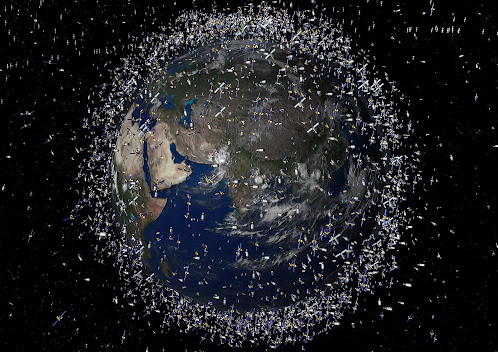Where man goes, waste follows. Call it garbage, trash, refuse, litter, rubbish – or even space junk.
Space junk usually becomes a hot topic only when there is
some large object that finally must yield to gravity with its final landing
spot largely unknown. Although the likelihood of a water impact is greatest,
anxious eyes turn to the skies just in case.
In reality, though, such high-profile encounters between
worn-out satellites and our home planet are merely the tip of the proverbial
iceberg. According to NASA’s Orbital Debris Program Office, located at Johnson
Space Center in Houston, Texas, there are upwards of 500,000 marble-sized
objects circulating in orbit, joined by millions of objects 1mm or smaller.
In early July The Washington Post wrote about the US Space
Force’s quest to establish a military identity and identify what concrete
responsibilities this newest branch of the Armed Forces of the United States
will have. The article referred to low earth orbit tests of satellite
destruction that have already been conducted by Russia and China, as well as
speculation that any Chinese action against Taiwan will be predicated on the
destruction of numerous satellites to hamper the defense of Taiwan by its own
forces and allies.
Of course, any destruction of satellites is an act of
creation: the generation of more space junk in low earth orbit.
Putting aside the topic of satellite warfare, what to do
about the problem that already exists? As might be expected with such a complex
issue, opinions vary widely. There have been many proposals and ideas, some translated
into proof-of-concept missions like Surrey Space Centre’s RemoveDEBRIS and
Japanese company Astroscale’s ELSA-d.
At the moment, one of the most promising efforts taking
concrete steps to mitigate the danger of debris in orbit is the ESA (European
Space Agency) alliance with the Swiss company ClearSpace SA. They intend to
target a VESPA payload adapter, a refrigerator-sized object that has remained
in orbit since playing a role in a 2013 ESA Vega mission. Scheduled for 2026, the
ClearSpace-1 mission will attempt to rendezvous with VESPA, capture the object,
and guide it to a harmless destruction upon reentry to our atmosphere.
Ironically – and fully indicative of the urgency of
ClearSpace’s mission - just a month ago the VESPA target was itself hit by a small piece space junk, the resulting debris from the collision adding to the amount of trackable objects
already in orbit. ClearSpace is analyzing what impact the collision may have on
its planned mission to capture and safely deorbit VESPA.
Although ClearSpace remains for now an imposing distance
away from being able to reduce the threat of the hundreds of thousands of small
objects crowding space, the start of ClearSpace-1 is far better than no action
at all.
For more information, please visit:
ClearSpace: https://clearspace.today/
NASA Orbital Debris Program Office: https://www.orbitaldebris.jsc.nasa.gov/




